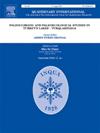Cold and arid climates experienced by Central European hunter-gatherers at Stránská skála IV during the Last Glacial Maximum
IF 1.8
3区 地球科学
Q3 GEOGRAPHY, PHYSICAL
引用次数: 0
Abstract
Several studies have argued that human presence in Central Europe during the Last Glacial Maximum (LGM) may have been restricted to brief periods of climate warming. In particular, Greenland Interstadial-2 (GI-2, c.23,300–22,800 BP), a brief warm event recorded in Greenland ice-core stratigraphy, has been associated with human activity at Central European sites such as Kastelhöhle-Nord and Y-Höhle (Switzerland), and Kammern-Grubgraben (Austria). The Epigravettian open air site of Stránská skála IV, a specialized horse hunting site located in Moravia (Czech Republic), purportedly provides further evidence in support of this hypothesis. However, published radiocarbon dates from Stránská skála IV have age ranges too broad for evaluating the relationship between the chronology of occupation and Greenland ice core stratigraphy events, and low pollen abundance at the site means pollen analysis is an uncertain indicator of climatic conditions. Through a new program of radiocarbon dating and stable isotope analysis of the hunted horse remains from Stránská skála IV, we refine the chronology of the site and provide new insights into environmental conditions during human occupation. Bayesian modelling of seven new ultra-filtered AMS dates moves the timing of site occupation back from 22.8 to 21.1 ka cal. BP to 24.1–23.0 ka cal. BP, indicating that site use occurred prior to GI-2. Stable carbon, nitrogen and sulfur bone collagen isotope results suggest that conditions were cool and arid with an open landscape. Tooth enamel oxygen isotope data indicate mean annual air temperatures of 1.2°C (±3.5°C), consistent with climate-modelled temperature estimates for the region during the LGM. Together these data point to human occupation of the site during pronounced cold conditions characterized by temperatures ∼8.5°C below the present-day average. Our results demonstrate that human presence in central Europe during the LGM was not confined to brief warm events, adding to a growing body of evidence that early humans could tolerate more extreme climate conditions than previously thought. Perhaps, at certain times in prehistory climate played a less deterministic role in human distribution than is often assumed.
末次盛冰期Stránská skála IV处中欧狩猎采集者所经历的寒冷和干旱气候
一些研究认为,人类在末次盛冰期(LGM)在中欧的存在可能仅限于短暂的气候变暖时期。特别是格陵兰冰芯地层记录的一个短暂的暖化事件——格陵兰Interstadial-2 (gis -2,约23,300 - 22,800 BP),已与中欧遗址(如Kastelhöhle-Nord和Y-Höhle(瑞士)和Kammern-Grubgraben(奥地利))的人类活动联系起来。位于摩拉维亚(捷克共和国)的Epigravettian露天遗址Stránská skála IV是一个专门的猎马遗址,据称为支持这一假设提供了进一步的证据。然而,Stránská skála IV公布的放射性碳年代数据的年龄范围太广,无法评估占领年代与格陵兰冰芯地层事件之间的关系,而且该地点的花粉丰度低意味着花粉分析是气候条件的不确定指标。通过对Stránská skála IV中被猎杀的马遗骸进行放射性碳定年和稳定同位素分析的新项目,我们完善了该遗址的年代,并为人类居住期间的环境条件提供了新的见解。7个新的超滤AMS数据的贝叶斯模型将场地占用时间从22.8 - 21.1 ka cal. BP向后移动到24.1-23.0 ka cal. BP,表明场地使用发生在GI-2之前。稳定的碳、氮和硫骨胶原同位素结果表明,当时的环境寒冷干旱,景观开阔。牙釉质氧同位素数据表明,年平均气温为1.2°C(±3.5°C),与LGM期间该地区气候模拟的温度估计一致。总之,这些数据表明,人类在明显寒冷的条件下占领了该遗址,其特征是温度比现在的平均温度低约8.5°C。我们的研究结果表明,在LGM时期,人类在中欧的存在并不局限于短暂的温暖事件,这增加了越来越多的证据,表明早期人类可以忍受比以前认为的更极端的气候条件。也许,在史前的某些时期,气候对人类分布的决定性作用不如人们通常认为的那样大。
本文章由计算机程序翻译,如有差异,请以英文原文为准。
求助全文
约1分钟内获得全文
求助全文
来源期刊

Quaternary International
地学-地球科学综合
CiteScore
5.60
自引率
4.50%
发文量
336
审稿时长
3 months
期刊介绍:
Quaternary International is the official journal of the International Union for Quaternary Research. The objectives are to publish a high quality scientific journal under the auspices of the premier Quaternary association that reflects the interdisciplinary nature of INQUA and records recent advances in Quaternary science that appeal to a wide audience.
This series will encompass all the full spectrum of the physical and natural sciences that are commonly employed in solving Quaternary problems. The policy is to publish peer refereed collected research papers from symposia, workshops and meetings sponsored by INQUA. In addition, other organizations may request publication of their collected works pertaining to the Quaternary.
 求助内容:
求助内容: 应助结果提醒方式:
应助结果提醒方式:


